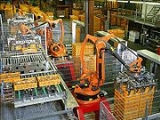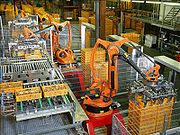
Logistics automation
Encyclopedia
Logistics automation is the application of computer software
and/or automated machinery to improve the efficiency of logistics
operations. Typically this refers to operations within a warehouse or distribution center, with broader tasks undertaken by supply chain management
systems and enterprise resource planning
systems.
Logistics automation systems can powerfully complement the facilities provided by these higher level computer systems. The focus on an individual node within a wider logistics network allows systems to be highly tailored to the requirements of that node.
 Logistics automation systems comprise a variety of hardware and software components:
Logistics automation systems comprise a variety of hardware and software components:
s), or other companies (e.g. wholesale
rs). A logistics automation system may provide the following:
A complete warehouse automation system can drastically reduce the workforce required to run a facility, with human input required only for a few tasks, such as picking units of product from a bulk packed case. Even here, assistance can be provided with equipment such as pick-to-light units. Smaller systems may only be required to handle part of the process. Examples include automated storage and retrieval systems, which simply use cranes to store and retrieve identified cases or pallets, typically into a highbay storage system which would be unfeasible to access using fork-lift trucks or any other means.
Computer software
Computer software, or just software, is a collection of computer programs and related data that provide the instructions for telling a computer what to do and how to do it....
and/or automated machinery to improve the efficiency of logistics
Logistics
Logistics is the management of the flow of goods between the point of origin and the point of destination in order to meet the requirements of customers or corporations. Logistics involves the integration of information, transportation, inventory, warehousing, material handling, and packaging, and...
operations. Typically this refers to operations within a warehouse or distribution center, with broader tasks undertaken by supply chain management
Supply chain management
Supply chain management is the management of a network of interconnected businesses involved in the ultimate provision of product and service packages required by end customers...
systems and enterprise resource planning
Enterprise resource planning
Enterprise resource planning systems integrate internal and external management information across an entire organization, embracing finance/accounting, manufacturing, sales and service, customer relationship management, etc. ERP systems automate this activity with an integrated software application...
systems.
Logistics automation systems can powerfully complement the facilities provided by these higher level computer systems. The focus on an individual node within a wider logistics network allows systems to be highly tailored to the requirements of that node.
Components

- Fixed machinery
- Automated cranes (also called automated storage and retrieval systems): provide the ability to input and store a container of goods for later retrieval. Typically cranes serve a rack of locations, allowing many levels of stock to be stacked vertically, and allowing far high storage densities and better space utilization than alternatives.
- Conveyors: automated conveyors allow the input of containers in one area of the warehouse, and either through hard coded rules or data input allow destination selection. The container will later appear at the selected destination.
- Sortation, or sorting systems: similar to conveyors but typically have higher capacity and can divert containers more quickly. Typically used to distribute high volumes of small cartons to a large set of locations.
- Industrial Robots: four to six axis industrial robots, e.g. palletizing robots, are used for palletizing, depalletizing, packaging, commissioning and order picking.
- Typically all of these will automatically identify and track containers based upon barcodeBarcodeA barcode is an optical machine-readable representation of data, which shows data about the object to which it attaches. Originally barcodes represented data by varying the widths and spacings of parallel lines, and may be referred to as linear or 1 dimensional . Later they evolved into rectangles,...
s, or increasingly, RFID tags - AS/RS — Automated Storage and Retrieval SystemAutomated Storage and Retrieval SystemAn automated storage and retrieval system consists of a variety of computer-controlled methods for automatically placing and retrieving loads from specific storage locations...
s. Vertical Carousels based on the paternosterPaternosterA paternoster or paternoster lift is a passenger elevator which consists of a chain of open compartments that move slowly in a loop up and down inside a building without stopping. Passengers can step on or off at any floor they like...
system or with space optimisation, these can be thought of as large scale vending machines, giving the same easy access to physical objects as we have become accustomed to with respect to data.
- Motion check weigherCheck weigherA checkweigher is an automatic machine for checking the weight of packaged commodities.It is normally found at the offgoing end of a production process and is used to ensure that the weight of a pack of the commodity is within specified limits...
s may be used to reject cases or individual products by checking them for underweight conditions and rejecting the item. They are often used in kitting conveyor lines to ensure all pieces belonging in the kit are present. Large wholesalers and retail club stores insist on receiving the exact amount of product in each package as specified. - Mobile technology
- Radio data terminals: these are hand held or truck mounted terminals which connect by wireless to logistics automation software and provide instructions to operators moving throughout the warehouse. Many also have in-built bar code scanners to allow identification of containers. Bar codes allow the automatic capture of data without use of the computer keyboard, which is slow and error prone.
- Software
- Integration software: this provides overall control of the automation machinery and for instance allows cranes to be connected up to conveyors for seamless stock movements.
- Operational control software: provides low-level decision making, such as where to store incoming containers, and where to retrieve them when requested.
- Business Control software: provides higher level functionality, such as identification of incoming deliveries / stock and scheduling order fulfillment, assignment of stock to outgoing trailers.
Benefits of logistics automation
A typical warehouse or distribution center will receive stock of a variety of products from suppliers and store these until the receipt of orders from customers, whether individual buyers (e.g. mail order), retail branches (e.g. chain storeChain store
Chain stores are retail outlets that share a brand and central management, and usually have standardized business methods and practices. These characteristics also apply to chain restaurants and some service-oriented chain businesses. In retail, dining and many service categories, chain businesses...
s), or other companies (e.g. wholesale
Wholesale
Wholesaling, jobbing, or distributing is defined as the sale of goods or merchandise to retailers, to industrial, commercial, institutional, or other professional business users, or to other wholesalers and related subordinated services...
rs). A logistics automation system may provide the following:
- Automated goods in processes: Incoming goods can be marked with barcodeBarcodeA barcode is an optical machine-readable representation of data, which shows data about the object to which it attaches. Originally barcodes represented data by varying the widths and spacings of parallel lines, and may be referred to as linear or 1 dimensional . Later they evolved into rectangles,...
s and the automation system notified of the expected stock. On arrival, the goods can be scanned and thereby identified, and taken via conveyors, sortation systems, and automated cranes into an automatically assigned storage location. - Automated Goods Retrieval for Orders: On receipt of orders, the automation system is able to immediately locate goods and retrieve them to a pickface location.
- Automated despatch processing: Combining knowledge of all orders placed at the warehouse the automation system can assign picked goods into despatch units and then into outbound loads. Sortation systems and conveyors can then move these onto the outgoing trailers.
- If needed, repackaging to ensure proper protection for further distribution or to change the package format for specific retailers/customers.
A complete warehouse automation system can drastically reduce the workforce required to run a facility, with human input required only for a few tasks, such as picking units of product from a bulk packed case. Even here, assistance can be provided with equipment such as pick-to-light units. Smaller systems may only be required to handle part of the process. Examples include automated storage and retrieval systems, which simply use cranes to store and retrieve identified cases or pallets, typically into a highbay storage system which would be unfeasible to access using fork-lift trucks or any other means.

